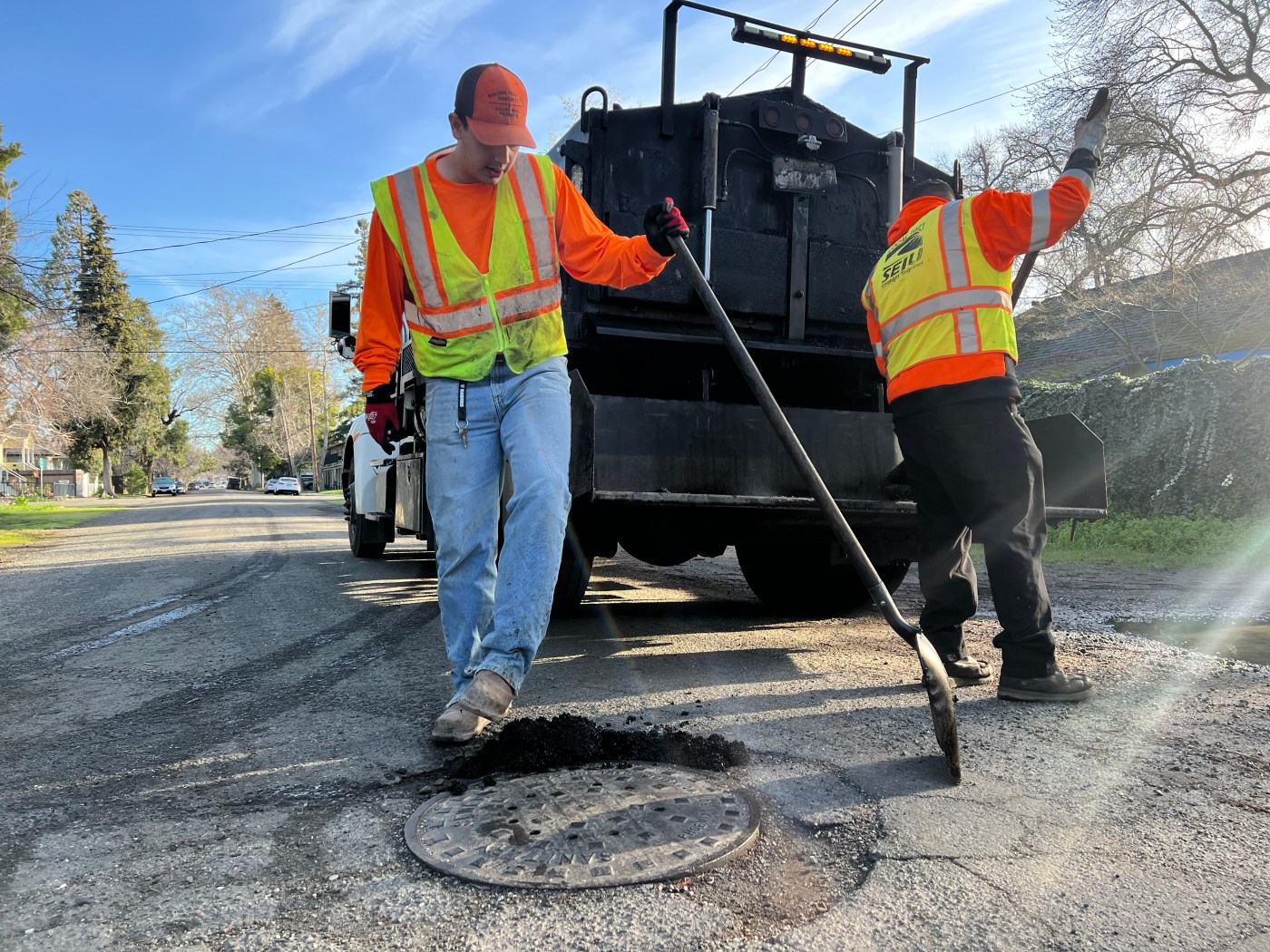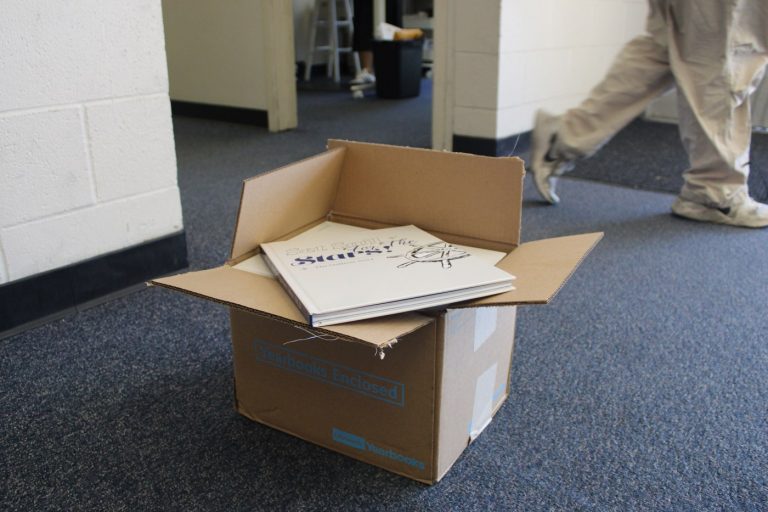CHICO — Last year Chico’s maintenance employees completed 650 service requests for potholes alone.
The number of potholes filled last year is far beyond 650. When the right of way maintenance arm of Public Works receives a request to fill a pothole, the employees address all potholes in the general area of the one that is requested.
Senior maintenance worker, Justin Orozco, said in 2023 Public Works filled “thousands,” of potholes.
Orozco has been working for right of way maintenance for five years, and said the streets have gotten worse in that time.
Justin Orozco removes chunks of asphalt from a pothole with Right of Way field supervisor Kirby Faulkner in Chico, California on Feb. 22, 2024. (Molly Myers/Enterprise-Record)
Multiple Public Works employees said the public has the misconception that no one is fixing the roads and filling potholes.
“We are out everyday, I promise you guys,” Orozco said. “I mean it’s two of us, and it’s hard to get to every hole that everyone turns in.”
Kirby Faulkner, right of way maintenance supervisor, said their team fills 75-125 potholes daily.
Since the start of December, right of way maintenance used 50 tons of asphalt and they just ordered 25 more tons, Faulkner said.
Limitations
Ideally, Faulkner would like to see a two part system to road repairs: one part that operates on a set schedule, and another that responds to specific requests.
However, the current system only operates on a request-based service.
Monday through Thursday two people from the city’s Public Works are out filling service requests for potholes. On Friday they try to get to other pressing issues like graffiti, illegal dumping, sidewalk repairs, cleaning storm drains and grading shoulders.
In the summer they usually have a crew of up to five people.
Kirby Faulkner, Miguel Rodriguez and Justin Orozco fill potholes in Chico, California on Feb. 22, 2024. (Molly Myers/Enterprise-Record)
Faulkner said Public Works is currently understaffed, but employment is rising. Part of the issue is that some employees are on leave, but they will eventually be returning.
“We’re getting back to fully staffed, but no I think we still need more,” Faulkner said.
One of the issues regarding staffing is funding.
“The wages aren’t where they need to be, and they (potential employees) can get a job on the outside in the private sector doing the same thing for more,” Faulkner said.
Faulkner said that the city is expanding, and new neighborhoods means more work for public works to tend to. Without more maintenance workers “other neighborhoods are going to get left behind,”
“The city is growing, and we still have the same hierarchy of people with more work to do,” Faulkner said. “The city is growing, but we aren’t.”
Staffing also affects the kinds of road maintenance Public Works can address.
Sometimes right of way maintenance gets requests for divots or entire roads that need to be repaired.
For a pothole to be filled it needs to be 1.5 inches deep, said Orozco. This is because the asphalt needs edges to grip onto. If they get a call for a hole that is too shallow, or a divot, they have to wait until summer when they use a stronger mix.
The finished product of a filled pothole in Chico, California on Feb. 22, 2024. (Molly Myers/Enterprise-Record)
If they get a call and it turns out the entire road needs repairs, they also wait until summer to use the stronger asphalt and because they have a larger crew in the summers for bigger projects.
What causes potholes?
Orozco and Faulkner listed multiple pothole perpetrators:
• Rain and floods
• Traffic and increase in population growth
• Semitrailers and dump trucks putting immense weight on the roads
• The fact that lots of roads in Chico are very, very old
The seasons affect the materials and strategies right of way maintenance uses to maintain the streets.
Winter maintenance
The asphalt, the mixture of rocks, sand and oil used to fill potholes, changes depending on the seasons.
In the winter, public works uses a premade mixture called Hydro Patch that is kept at air temperature and needs no prep before filling a pot hole.
This mixture isn’t as durable as the summer mixture, but it can fill potholes that are wet or filled with water and still adhere to the hole.
After shoveling the asphalt into each hole, Orozco used his shoe to smooth the asphalt before using a hand tamper to flatten the surface of the filled hole.
Faulkner called it “the ol’ shoe method.”
Justin Orozco smooths fresh asphalt into a pothole before it is tampered into the ground in Chico, California on Feb. 22, 2024. (Molly Myers/Enterprise-Record)
Cars can drive on the winter asphalt immediately after it is put in the ground. The mixture is a little sticky when you step on it and has a slight give, but it won’t move or transfer.
Summer maintenance
“The ol’ shoe method” would not work with the asphalt mixture used in the summer.
When the weather heats up, so does the asphalt. The stronger-summer asphalt is applied at “400 or 500 degrees,” Orozco said.
The summer asphalt has a much stronger grip compared to the winter asphalt.
“It’s probably the messiest stuff I’ve ever worked with in my life,” Orozco said.
After filling pot holes with the summer asphalt, the area needs to be coned off or tapped off so cars don’t drive on it right away.
The summer mixture can only be applied to dry streets, so there is no pothole maintenance when it is raining.
Service requests can be made by emailing Public Works at [email protected] or calling 530-894-4200.
Related Articles
Close but no consensus on Chico council
Oroville plans for major north-to-south bicycle corridor
Downtown Chico Complete Streets Project review rescheduled
2.47 million pounds of coal dumped in Plumas County train derailment
Rockslides cleared; Highway 70 to reopen one-way traffic













+ There are no comments
Add yours